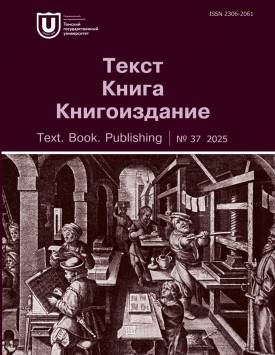Myth of the labyrinth feminine reception: Ariadne by Jennifer Saint
The article examines the artistic interpretation of the myth of the real and metaphorical labyrinths in Jennifer Saint's novel Ariadne, inextricably linked with the myth of Ariadne and her men - Theseus and Dionysus. The key to the Saint's perception of the myth is in the title, epigraph and prologue of the novel, which develop the triune task the writer solved: to show the myth in the perception of a woman through the use of the female self-narrative; to picture the dichotomy of the female and male worlds; to explore abusive relationships, in which a man acts as an aggressor, a woman as a victim. The novelist consistently considers these issues, without changing the essence of the myth, but conjecturing it and subtly psychologizing the entire narrative. Saint reveals the depravity of phallocentric power, which disfigures a woman who comes to disobedience and rebellion in search of selfhood - the integrity and unity of the personality; emphasizes the problems of the humiliated position of a woman in a masculine society, her world and self-knowledge; inscribes the story of Ariadne in other feminine myths of Ancient Greece. In this case she becomes close to the ideas of the feminist essay of the French post-structuralist Helene Cixous "The Laughter of Medusa". The boastful and deceitful male discourse in the novel is opposed by the female self-referential discourse of Ariadne and, to some extent, Phaedra, in whose streams of consciousness the deep meanings of the labyrinth metaphor are recreated. This is how a novel that represents a feminine picture of the world and its mythological and cultural-philosophical foundations, which ultimately leads to a revision of gender relations and roles, to the fixation of gender perversions, to the construction of a female model of the Home chronotope, to the Home/Anti-home dichotomy. The author declares no conflicts of interests.
Keywords
Jennifer Saint,
Ariadne,
labyrinth myth,
labyrinth metaphor,
feminine reception,
Helen CixousAuthors
| Ishimbayeva Galina G. | Ufa University of Science and Technology | galgrig7@list.ru |
Всего: 1
References
Юнг К.Г. Архетип и символ: пер. с нем. М. : Renaissance, 1991. 304 с.
Лауэнштайн Д. Элевсинские мистерии / пер. с нем. Н. Федоровой. М. : Энигма, 1996. 368 с.
Кэмпбелл Дж. Герой с тысячью лицами / пер. с англ. К. Семенова. Киев : София, Ltd., 1997. 336 с.
Лотман Ю.М. Выход из лабиринта // Умберто Эко. Собрание сочинений : в 4 т. Т. 1. Внецикловый роман и эссе. СПб. : Симпозиум, 1998. С. 650-669.
Тойнби А. Дж. Постижение истории : сборник / пер. с англ. Е.Д. Жаркова. М. : Рольф, 2001. 640 с.
Фрэзер Дж. Дж. Золотая ветвь: Исследование магии и религии : в 2 т. Т. 1: Гл. I-XXX1X / пер. с англ. М. Рыклина. М. : ТЕРРА-Книжный клуб, 2001. 528 с.
Хендерсон Дж.Л. Древние мифы и современный человек // Человек и его символы / К.Г. Юнг и др. М. : Медков С.Б.; «Серебряные нити», 2016. С. 105-161.
Фрейд З. «Я» и «Оно» / пер. с нем. Л. Голлербах, И. Ермакова. М. : Эксмо-Пресс, 2017. 160 с.
Кузнецова Н.В. Миф о Минотавре в художественном сознании XX века (А. Жид «Тесей», X. Кортасар «Цари», Х.Л. Борхес «Дом Астерия», Ф. Дюрренматт «Минотавр») // Вестник Московского университета. Серия 19. Лингвистика и межкультурная коммуникация. 2008. № 2. С. 108-113.
Сединина-Барковская Ю.А. Трансформация образа Минотавра в современной фантастической литературе (на материале дилогии Г. Л. Олди и А. Валентинова «Нам здесь жить» и трилогии Ю. Брайдера и Н. Чадовича «Охота на Минотавра») // Филологические штудии = Studia philologica. Минск : БГУ, 2009. Вып. 7. С. 127-136.
Денисова Т.Ю. Одиночество Минотавра // Идеи и идеалы. 2012. № 4 (14). Т. 2. С. 3-16.
Цветков Ю.Л. Античный миф и либретто Гуго фон Гофмансталя «Ариадна на Наксосе» // Вестник Нижегородского университета им. Н.И. Лобачевского. 2013. № 6 (2). С. 301-304.
Барма О. А. Концепция ризоморфного лабиринта в культуре постмодерна // Педагогические науки. Культурология. 2013. № 7. С. 123-126.
Колобаева Л.А. И. Бродский: Работа с античным мифом // Вестник Московского университета. Серия 9. Филология. 2015. № 2. С. 67-83.
Ишимбаева Г.Г. Сказочное ядро романа МХ. Данилевского «Дом листьев» // Проблемы изучения фольклора, литературы и языка. Челябинск : Изд-во ЧелГУ, 2023. С. 47-52.
Эко У. Заметки на полях «Имени розы» / пер. с итал. Е. Костюкович. М. : Астрель; CORPUS, 2012. 160 с.
Дженнифер Сэйнт // Каталог издательства CORPUS. URL: https://www.corpus.ru/authors/dzhennifer-sehjnt.htm (дата обращения: 02.05.2023).
Сэйнт Дж. Ариадна / пер. с англ Л. Трониной. М.: АсТ; CORPUS, 2023. 400 с.
Сиксу Э. Хохот Медузы / пер. с англ. О. Липовской // Введение в гендерные исследования. Ч. II: Хрестоматия / под ред. С.В. Жеребкина. Харьков : ХЦГИ, 2001; СПб. : Алетейя, 2001. С. 799-821.
Лотман Ю. М. Дом в «Мастере и Маргарите» // О русской литературе : статьи и исследования (1958-1993). СПб. : Искусство, 1997. С. 748-754.
Вальтер Ф. Отто. Дионис. Миф и культ / пер. А. Савдеевой. М. : Клуб Касталия, 2016. 224 с.
Жуков Д.А. Биология поведения богов и героев Древней Греции. СПб. : Изд-во Крита, 2015. 248 с.

